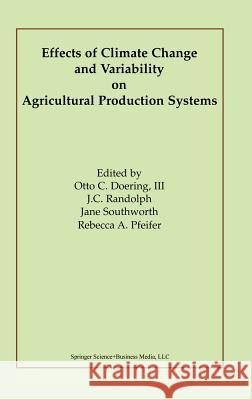Effects of Climate Change and Variability on Agricultural Production Systems » książka
Effects of Climate Change and Variability on Agricultural Production Systems
ISBN-13: 9781402070280 / Angielski / Twarda / 2002 / 275 str.
Effects of Climate Change and Variability on Agricultural Production Systems
ISBN-13: 9781402070280 / Angielski / Twarda / 2002 / 275 str.
(netto: 372,26 VAT: 5%)
Najniższa cena z 30 dni: 385,52 zł
ok. 20 dni roboczych.
Darmowa dostawa!
Evidence shows that global climate change is occurring. Research and debate continue on the role of increasing atmospheric concentrations of greenhouse gases in influencing climate change. Many sectors are or will be influenced by changing climate and climate variability, including increasing global temperatures, changing precipitation patterns, and increased frequency of unusual weather events. Agriculture and the world's supply of food and fiber are particularly vulnerable to such climate change. Effects of Climate Change and Viarability on the Agricultural Production Systems provides an integrated assessment of global climate change's impact on agriculture at the farm level, in the context of farm level adaptation decisions. Ten agricultural areas in the Upper Midwest region - the heart of the United States' corn belt - were subjected to climate change and changing climate variability scenarios through simulations of future climate using results from general circulation models. Crop growth models, calibrated to the study sites, were used to simulate yields under varying climate conditions. Farm level production and economic analyses were performed to determine what adaptation strategies might be best utilized to maintain production and profitability for producers under conditions of global climate change and changing climate variability. Similar integrated analyses from Australia and Argentina provide comparisons from different regions. The robust integrated systems methodology for assessing impacts and adaptation opportunities in several different major agricultural regions provides the reader with an example for similar endeavors. Also discussed are guidelines and useful analytical options for input suppliers, agricultural researchers, and agricultural producers to enable risk averting strategies and adaptations as global climate change plays out.











